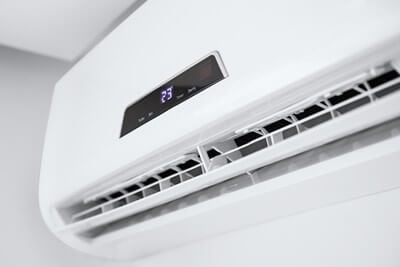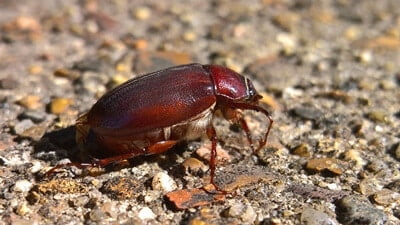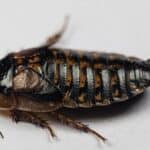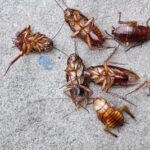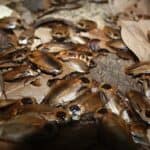Air conditioners are essential in many parts of the country. If you’re dealing with cockroaches, though, these machines can be a problem. HVAC systems and their air ducts wind throughout your home. Window AC units are also exposed to the outside world, which seems like an open invitation to bugs. Unfortunately, this concern is well-founded.
Air conditioners can attract cockroaches. HVAC systems and AC units offer a moist environment and open water source. The air conditioning process generates heat, which cockroaches like. AC units are enclosed and dark, which creates a safe haven. The air filters may also contain food for roaches to eat.
Even the most well-sealed HVAC system is at risk of cockroaches. During hot summers, cockroaches may seek out your air conditioner as a cooling reprieve from the weather. During cold times, roaches can gain more energy from the heat it generates. However, there are ways you can stop cockroaches from getting into your AC units.
Why Air Conditioners Attract Roaches
Finding cockroaches inside air conditioners and ducts is a common occurrence. This is true for AC units and HVAC systems alike because they offer an ideal living space.
Air conditioners have ample resources for a cockroach colony to exploit. Not only are roaches drawn to the spots, but they can thrive there for the following reasons:
Moisture
Roaches need water to survive. Depending on the AC unit you have, your air conditioner may provide a reliable water source. This is especially true for the Oriental cockroach, which prefers living near open water sources. They’ll easily infest these spots and spread bacteria.
Evaporative coolers, for example, often have a puddle of water gathered in their base. This allows normal air to be circulated over the water, which cools it down. It’s then dispelled into your home as cold air. By their design alone, these AC units can provide a pleasant, easy-to-access water source.
With that said, not all AC units provide this advantage to roaches. Modern AC units do not use water to cool air. Instead, what people usually see as water is technically referred to as condensate. This condensate is taken care of by a hose called the condensate line. This transports the built-up liquid to the outside of your home.
More efficient units do not need this line, however. They often do not create condensate during the cooling process.
Shelter
Aside from moisture, roaches love dark spaces. The interior of an AC unit offers this in abundance. Likewise, they’re placed in secluded areas, such as:
- A closet
- An isolated corner in the back of the home
- An attic
AC units may generate a considerable amount of noise. This encourages many home designers to place them away from areas that see lots of activity.
Beyond that, the units are often connected to thermostats. This leaves little reason for a person to change the temperature manually. This is convenient for you, but it is convenient for roaches as well. They won’t be disturbed by predators, allowing them to roam and breed freely.
Food
Window units are often placed near kitchens, bathrooms, or areas that see lots of human activity. As such, roaches may leverage these spots to hunt for food. Even if you’re diligent in cleaning up spills and crumbs, even the smallest bit of food can attract a roach.
An AC unit may have food inside it. These machines work by sucking in air from the inside of a home. If the air contains filth, this gets trapped in air filters. If those are not regularly cleaned, they can offer food to roaches. That’s because roaches are omnivorous, meaning they can eat almost any organic matter. Dirty air filters may contain:
- Dirt
- Dust
- Dry skin
- Hair
- Cockroach poop
Heat
Cockroaches are more active in warm environments. AC units, despite blowing cold air into your home, offer a perfect heat source for roaches. This is because of three main factors:
Electricity
AC units are powered by electricity, which in itself creates a lot of heat. Roaches have been known to infest electronics because of this. Common hot spots include:
- Routers
- Televisions
- Games consoles
Some roaches are also more likely to infest AC units. For example, the German cockroach is known to choose electronics over other hiding spots.
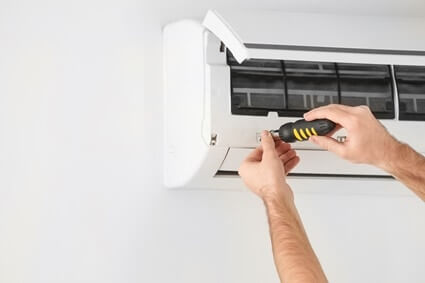
Fans
Aside from electricity, AC units generate heat through the air-cooling process itself. After all, once the heat has been removed from the air, it has to go somewhere.
To help move this heat outside of the AC unit and the home, fans inside blow the hot air out. You can easily feel the heat if you place a hand near the back of the machine. This spot is a warm, tidy place for roaches to nest.
More Use During Hot Months
Roaches are more active during the summer months, when your AC may be running more often. This creates a double-whammy:
- Roaches are more active, and therefore better able to find shelter.
- Your AC unit is more active, and therefore providing a better, more consistent shelter.
In these conditions, you can expect roach populations to explode.
Do Cockroaches Live In Air Conditioners?
As you can see, air conditions offer an ideal hub for cockroach species of every kind. As long as they can find a spot within the unit, they will nest. Once they’ve done so, they are unlikely to be removed. That’s because:
- Humans are unlikely to pry apart a well-functioning AC unit and find them.
- Cockroaches are nimble and only need a small spot within an AC unit to nest.
- Roaches can move in and out of AC units allowing them to hunt for food easily.
- The unit provides ideal shelter for roach eggs and growing offspring. This allows the population to grow.
- Cockroaches are unlikely to be troubled by predators here, such as cats or birds.
Of all the places for a roach to live, an AC unit may be the best.
Do Roaches Like Air Conditioning?
The air conditioning itself does not attract roaches. In fact, the cold air and noise put off cockroaches. However, the machine itself entices these pests. The design of the AC unit and byproducts of the air-cooling process is appealing.
Do Roaches Like Cold Air?
Cockroaches are less active in cold environments since they’re cold-blooded insects. If temperatures drop too low, roaches may become:
- Slow
- Lethargic
- Disoriented
- Unable to reproduce
- Enter a hibernation-like state
As such, they prefer hot weather over cold weather. If outdoor temperatures climb too high, though, cockroaches will seek out cold air to protect themselves. Whether that’s near or above 95 degrees Fahrenheit will become uncomfortable. This may encourage a roach to seek out your AC unit as a cooling reprieve.
Do Cockroaches Hate Air Conditioning?
As mentioned, there are several benefits to AC for cockroaches. That doesn’t mean it’s without flaws, though. The loud motor and working parts of an AC unit may frighten off roaches. If they have other sources of shelter, water, and food, they may pass it by.
Likewise, the cold air that an AC unit produces can actually harm a roach. If a roach nestles in the wrong spot of an HVAC system, it may be inundated with cold air. This will drop its body temperature and cause it to become lethargic. In this state, it may be unable to scavenge for food, run from danger, or reproduce.
If the temperatures drop below freezing, it may even go into a hibernation-like state. Here, it will starve and eventually die. That’s why cockroaches tend to nestle into a warm section of the AC unit.
With that said, roaches can circumvent these downsides. The noise can be ignored when there’s sufficient shelter and food. Likewise, if they feel the temperature becomes frigid, they can flee to warmer spots. Cockroaches tolerate the disadvantages and love the advantages.
Can Roaches Enter Through Air Conditioners?
Unfortunately, cockroaches do enter through air conditioners. Because of the machines’ design, they can even serve as a highway to the inside of your home.
According to the Proceedings of the National Academy of Sciences, roaches can squeeze through the smallest crack. A gap as small as 3 millimeters will suffice.
If you have an HVAC system, there are even more chances for a roach to enter your home. Ventilation systems often wind throughout your walls, attic, and basement. This provides several entry points for a roach, so they can:
- Crawl into floor vents once they’re inside your home
- Squeeze into cracks along the air ducts
- Exploit the seals between your walls and the vents
- Enter the AC unit itself and then travel through the vents and into the rest of your home
Can Cockroaches Get In Through Window Air Conditioning?
Likewise, roaches can use window AC units to gain entrance into your home. By design, these units are placed in a window, which is then closed down on top of them. The gaps surrounding the unit should be filled in with boards, chalking, or insulation. If this process is not done correctly, a roach can manipulate any minor gaps.
Likewise, the back half of a window AC is exposed to the outdoors. Cockroaches may be able to squeeze in through the vents which intake air. If the unit is in despair, it may have cracks along its metal frame or box. Cockroaches can also manipulate these points to crawl inside.
Once they’re nestled within the window AC unit, they can crawl out through the front. This lets them explore your home at their convenience.
What Damage Can Roaches Do In AC Units?
It’s important to remove any cockroaches from your air conditioning. If left undisturbed, they can cause an impressive amount of damage, such as:
- Eating through wires
- Building nests up against filters or air intake vents, therefore blocking them
- Defecating or shedding skins within the unit. This can blow contaminated air into your home
- Growing in population and spilling out into your main home
- Spreading their colony into your walls, vents, and ceiling
Roaches have been known to cause asthma, especially in children. This is according to an article published in Allergy Asthma and Immunology Research. The contaminated air spread by an infested AC unit or HVAC system may also cause respiratory issues in adults. Those with compromised immune systems, asthma, or those who are elderly are at the greatest risk.
How To Handle Cockroaches In Air Conditioning Vents
There are ways to deal with roaches in your AC unit:
Install Air Vent Filters
Air filters create a barrier between the outside world and the inside of your air conditioning. Most units have these as a standard. However, you can also buy filters that attach to the opening of the vents themselves. These provide an added layer of protection since they’re:
- Composed of a thick mesh, which blocks dirt, debris, and bugs
- It can be bought in bulk sheets and easily cut to size, leaving no gaps for roaches
- Able to filter out extra hair, dead skin, or dirt, which would attract roaches
With that said, air vent filters increase the strain put on your ventilation system. It will be forced to burn more energy to drag air through the thicker filters. It’s recommended that you only place these in rooms where people spend the most time, like bedrooms.
In the case of an infestation, you can place filters where you believe there are roaches. Once the roaches are dealt with, you can remove the filters.
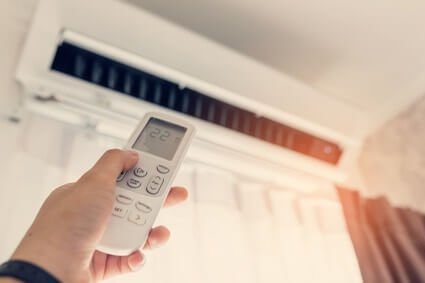
Clean Your AC
Cleaning your AC is the first step to deterring roaches. It’s wise to have your AC professionally cleaned once a year. If your region sees a lot of dust or dirt, this should be more frequent.
A quick clean is enough for most units, but not for those with an existing infestation. These must be thoroughly scrubbed down, with every nook and cranny inspected. No source of food should be left behind.
Call An Exterminator
In extreme cases, you may need the help of an exterminator. These professionals will have:
- More advanced insecticides, which can be localized. This will keep the poison from being spread through your home via the fans.
- Specialized insight. This will help the professional narrow down exactly where roaches are nesting.
- Follow-up treatments. Roaches can’t always be killed in a fell swoop, especially if they’re infesting your walls and vents. A professional can apply repeat treatments.
- Preventative steps. An exterminator will help you identify issues that need addressing. Following that, the professional can recommend steps to help you prevent roaches from coming back.
Do Not Use Sprays
Never spray insecticide directly into the AC unit or vents. It’s unlikely to kill roaches if they are hiding inside. A spray can only reach so far. Chances are, the roaches are already alerted to your presence. They will crawl to the farthest corner of the unit or vent.
Instead, you’ll circulate this poison back into your home through the vents. Insecticide can take a long time to dissipate. It will have serious effects on humans when inhaled.
How To Prevent Bugs From Coming Through Air Conditioners
When it comes to roaches, prevention is better than cure. Here are some tips to make sure that you never have to deal with roaches in your AC.
Close Gaps
If you think roaches entered your home through the air conditioning, then look for gaps. These may be:
- In your walls
- Along the vents
- In your attic
- Along the sides of your window AC unit
- In the seals around your HVAC system
Should you find any gaps, it’s recommended to close them with foam weather-stripping. This material will expand in the middle of the gap, creating a seal between any cracks. For smaller gaps, you can use rope caulk to cover any holes.
As a bonus, this will save on energy. Fewer gaps mean fewer air leaks, which causes less strain to cool your home.
Check For Cracks In Vents
Vents are a prime entry point for cockroaches. As such, make sure your HVAC system or AC unit doesn’t offer clear gaps in these spots. To check for leaks, hold a thin piece of toilet paper next to seams while the HVAC system is on. The toilet paper should not be:
- Sucked into the seam
- Blown away from your hand
If the vent fails this test, you should:
- Prepare it by cleaning the area and ensuring it’s dry
- Seal any leaks with mastic sealant, or aluminum foil tape
Note that there are instances wherein you can’t seal cracks yourself. Areas better left to a professional include:
- Disconnected sections
- Damp areas
- Spots with mold
Whether you handle it DIY or with professional input, make sure you’re thorough. While roaches don’t infest every air conditioner they find, it is a prime haven for this insect. Once a colony has rooted itself in, you should take immediate action to clear out the infestation.
